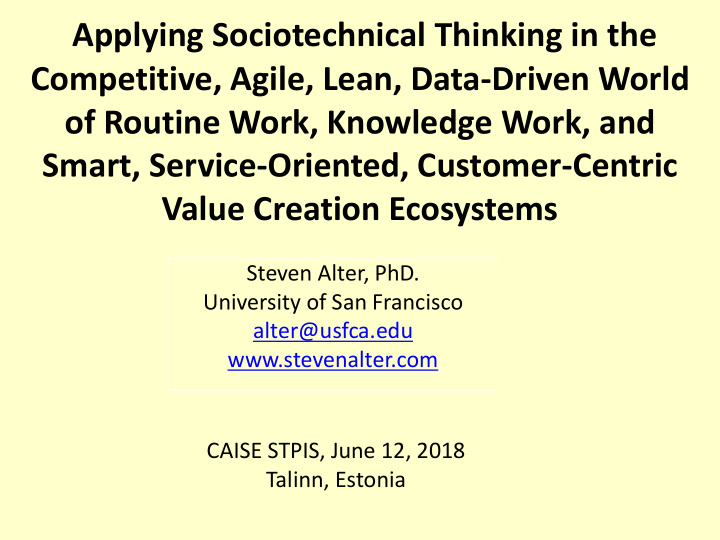



Applying Sociotechnical Thinking in the Competitive, Agile, Lean, Data-Driven World of Routine Work, Knowledge Work, and Smart, Service-Oriented, Customer-Centric Value Creation Ecosystems Steven Alter, PhD. University of San Francisco alter@usfca.edu www.stevenalter.com CAISE STPIS, June 12, 2018 Talinn, Estonia
Why do we keep saying that STS involves two systems instead of one? From CFP of the 4th International Workshop on Socio-Technical Perspective in IS development (STPIS'18)
Consider your employer and your work setting • Define the technical system. • Define the social system. • Explain a path toward their joint optimization in the sense that Mumford (2006) described it: – “ The objective of socio- technical design has always been ‘the joint optimization of the social and technical systems.” …. “Relationships between the two systems, and between them and the outside environment, must also be carefully analysed. This approach led to the development of a complex method for analysing work systems, which went through a number of stages. Unit operations, or groups of tasks that fitted logically together into a discrete work activity, were first identified. Each of these unit operations was made the responsibility of a work group. Next, variances – problem areas where what did happen deviated from what should happen – were noted as areas for improved control by the work group. … All of these were to become the responsibility of the work group.”
Think about the two separate systems in your work setting: • Explain whether the processes and activities are part of the technical system or social system. • Explain whether the relevant information is part of the technical system or social system. • Explain whether the technology is part of the technical system or social system. • Explain whether the product/services that are produced are part of the technical system or social system. • Explain whether the relevant aspects of the surrounding environment are technical or social.
30 th Sociotechnical Roundtable in San San Francisco, Sept. 2017 • Many different sociotechnical approaches – North American STS, Australian STS, Scandinavian STS, Dutch STS • I heard no one speak seriously about joint optimization of social and technical systems. • Yes, STS is becoming a footnote in some circles. What would bring it to the foreground?
Sociotechnical Thinking • Business results matter. • People matter. • Technology matters. • Information matters. • All are intertwined within the same systems, which can be described as work systems. • Impractical to pursue separate social and technical systems.
Work System Framework (static view – assuming some on-going adaptation)
Work System Life Cycle Model (iterations include planned and emergent change) Operation & Initiation Maintenance Development Implementation
Conditions and Paradoxes that Limit the STS Movement • Diffusion of ideas vs. diffuseness of message. • Values vs. methods • Complexity vs. teachability and usability • Human welfare vs. managerialist focus.
Topics and Issues that STS Should Be Able to Address • Smart devices and • Competition systems • Agile and agility • Service-orientation • Lean • Customer-centricity • Data-driven decisions • Value Creation • Routine work • Value Co-creation • Knowledge work • Business ecosystems
Work System Method • 1) identify the smallest work system that has the problem or opportunity; • 2) summarize the “as - is” work system using a work system snapshot, a stylized one page summary; • 3) evaluate the work system’s operation using measures of performance, key incidents, social relations, and other change drivers or obstacles • 4) drill down further as necessary; • 5) propose changes by producing a work system snapshot of a proposed “to be” work system that will probably perform better; • 6) describe likely performance improvements.
WSM Guidelines for Sociotechnical Thinking • Treat “work system” as the unit of analysis. • Define work system in a way that facilitates visualization and analysis. • Attend to the various elements of a work system. • Maintain visibility of STS values and criteria. • Give up on analytical distinctions between social system vs. technical system.
WSM Guidelines for Sociotechnical Thinking (continued) • Balance the needs and importance of different stakeholders. • Support agility. • Recognize the inevitability of adaptation. • Recognize technological change. • Produce artifacts that support IT work. • Support change processes through easily used ideas.
Fit of WSM-Based Thinking with Today’s Business World • Sociotechnical thinking (work system as a single system) • Competitive . ( environment ) • Agile . ( processes and activities ) • Lean . ( processes and activities ) • Data-driven. (information) • Routine work and knowledge work . ( processes and activities ) • Smart . ( technologies ) • Service-oriented . ( product/services, customers ) • Customer-centric . ( customers ) • Value creation . ( processes and activities, product/services, customers ) • Ecosystem . ( environment )
Conclusion • Focus on sociotechnical thinking and values. • Eliminate assumptions about separate social and technical systems. • Recognize realities:
Recommend
More recommend